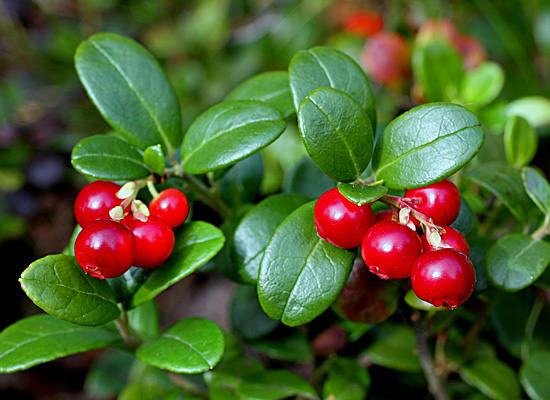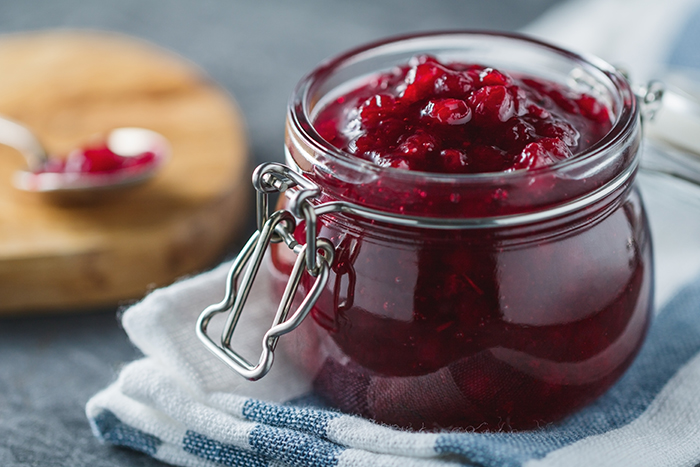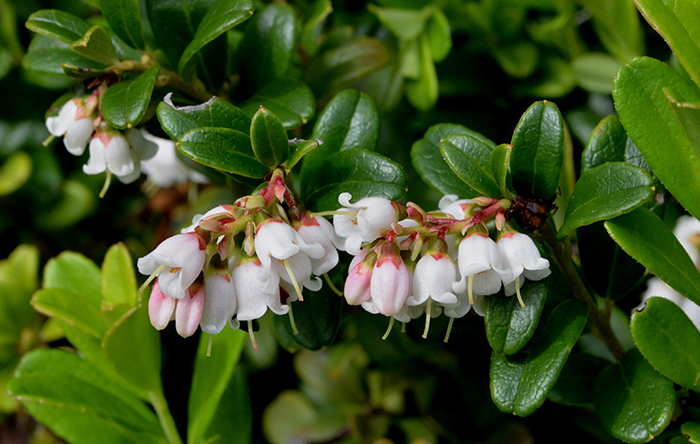Lingonberry
- Current Stock:
- 0
- Other Names:
- Red Whortleberry, Cowberry, Mountain Cranberry, Partridgeberry
- Latin Name:
- Vaccinium vitis-idaea
Lingonberries are a creeping shrub with tart and tangy, red berries closely related to highbush blueberries and cranberries. Their bright flavor and vibrant color make them an attractive and delicious addition to your edible native garden.
EDIBLE USES
Lingonberries are tart and acidic when picked fresh off the bush, and so they are often sweetened and cooked into jams, syrups, and baked goods. A strong tea of Lingonberry can be mixed with seltzer water or ginger ale for a unique and refreshing drink. They can also be made into liqueurs, wines, and fruit juices, or dried into leathers or “raisins”. They can be eaten for more savory purposes, such as being made into a sweet and tangy sauce to be served with potatoes, grains and meats, similar to cranberry sauce. Tart flavors are an essential and often overlooked flavor in a healthy diet, and Lingonberries are a great way to provide your tastebuds with more variety.
Lingonberries are high in anthocyanin, which is a source of the purple, blue and red colors in many crops, making Lingonberries an excellent natural alternative to food colorants.
Aside from being delicious and adding a much needed tart flavor to the palate, Lingonberries are high in antioxidants and vitamins A, C, and B.
NOTE: One study shows lingonberries need 800 chill hours to bear fruit. See map at the bottom of the page for reference.
ORNAMENTAL QUALITIES
Lingonberries are a woody, creeping, evergreen shrub ranging from 2-6 inches tall. Their leathery leaves are ovate and dark green on top, with lighter green coloration on the underside. In the winter their leaves turn a beautiful, shiny red color. Lingonberries have two bloom periods of small, bell shaped white or pink flowers from March-April and July-August. After the blossoms come the dark red berries, which are smaller than cranberries but otherwise similar in appearance. They take 3 or 4 years of growth from seedlings before producing fruit.
ENVIRONMENT AND CULTURE
Lingonberries are hardy, perennial shrubs which are suited to cooler climates and can survive freezing periods, although if they are frozen during their bloom or fruiting stages they can be up to 50% less productive. Lingonberries are native to the sandy, boreal, temperate forests and Arctic Tundra of the Pacific Northwest and grow amongst White and Black Spruces, Prickly Rose, Paper Birch, Mountain Laurel, and Fireweed.
Lingonberries are an important food source for birds migrating north in the spring, including Grouse, Thrushes, Geese, Sea Gulls, Partridges and Pheasants. The berries also provide food to many mammals such as Red Foxes, Black Bears, Chipmunks, and Red-Backed Voles.
The Lingonberry was and is a culturally significant plant to many Native Americans who carefully cultivated it in the wild. They used the leaves and berries fresh for food and medicine, preserving the berries through drying, making jellies, or boiling and canning them with oil. Fresh jellies of the berries were used for sore throats and colds, and the leaves were used to treat gout, rheumatism and bladder problems. Despite great cultural losses, they continue to work towards stewarding and restoring wild populations of Vacciniums throughout the region, both strengthening the integrity of the ecology and sustaining their cultural heritage and wisdom. These strong and recovering peoples and plants deserve our respect, gratitude, and reparations. (Learn more & how to help on our Charitable Giving page.)
HARVEST, CARE, AND PREPARATION
Lingonberries thrive and produce best in peaty, moist, acidic soil. In drier climates, they can do well in partial shade, but in cooler, wetter climates full sun is preferable. They don’t tend to like overly hot temperatures, and will do best in shade if planted in a hotter climate. Lingonberries spread through underground, rhizomatous runners and form mats of shrubbery.
Berries grow abundantly and can be harvested starting in mid-August, by hand or with berry combs. They will be dark red and firm, but with a little give.
Use them any way you might use a cranberry: in sweet and savory sauces, dried, frozen, in jams, baked goods, leathers, and more. You can also prepare the berries as a strong tea to mix with other seltzers and sodas for a refreshing late summer drink.
-
Native Range: AK, CT, MA, ME, MI, MN, NH, VT, WI
-
USDA zones: 2-8
- Chill Hours: minimum 800hrs
-
Ease of Care: Medium
-
Deer Resistance: Low
-
Light Requirements: Full Sun to Part-Shade, depending on climate
-
Soil Type: Peaty, acidic, moist
-
Water Requirements: Moist
-
Pollination: Bees, flies
-
Bearing Age: 3-4 years from establishment
-
Size at Maturity: 6-16 inches [OSU Extension]
-
Plant Spacing: 3-5 Feet
-
Bloom Time: March-April, July-August
-
Harvest Time: Mid-August - Mid-October












